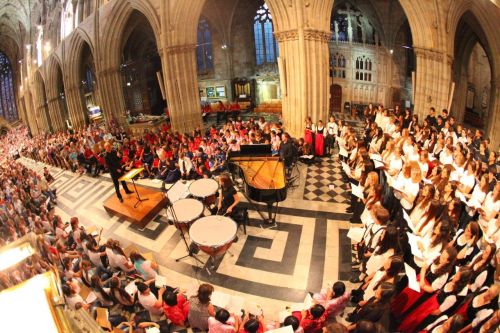 United Kingdom Thomas Jennefelt, Jón Ásgeirsson, Alberto Grau, Arne Mellnas, Caldwell/Ivory, Bob Chilcott: Gala Concert, First Worcester International Festival for Young Singers. Worcester Cathedral, 26.7.2013. (RJ)
United Kingdom Thomas Jennefelt, Jón Ásgeirsson, Alberto Grau, Arne Mellnas, Caldwell/Ivory, Bob Chilcott: Gala Concert, First Worcester International Festival for Young Singers. Worcester Cathedral, 26.7.2013. (RJ)

Choirs:
April Girls’ Choir, Russia,
Artemis Girls’ Choir, Belgium
Communidad de Madrid Youth Choir, Spain
DO-RE-MI Children’s Choir, Austria
Domino Children’s Choir, Czech Republic
Ozarenie Chamber Choir, Russia,
Sacred Heart Canossian College Choir, Hong Kong
Skowronki Girls’ Choir, Poland
Südpfalzlerchen Children’s and Youth Choir
Versme Children’s Choir, Lithuania
Worcestershire Young Singers, UK
Conductors: Carlo Pavese,
Margrét Bóasdóttir
Sanna Valvanne
Bob Chilcott
In the years following the Second World War music was perceived as a way of uniting formerly hostile nations. An important initiative to grow out of this idea is Europa Cantat – the European Choral Association – which brings together youth choirs from across the world to sing together and celebrate their musical heritage. Britain has been late in embracing this concept – more than 60 years late, in fact – but finally Worcester (famous for the Three Choirs’ Festival and Lee and Perrins’ Sauce) stepped forward to host the event under the auspices of Sing UK. Judging from the Gala Concert which ended the week’s activities, the UK has been missing out.
This is no element of competition in Europa Cantat; instead the choirs are put in workshops (known as ateliers) each directed by an internationally renowned choral director. In Worcester the eleven choirs represented ten different countries and the atelier leaders were from Italy, Iceland, Finland and the UK. The young people rehearse intensively and put on concerts in smaller venues during the course of the week culminating in the Worcester Cathedral event.
On the evening in question the audience were greeted with a peal of bells as they settled down for the concert. Next thing they found themselves surrounded on all sides by choristers imitating the sound of the bells under the direction of Carlo Pavese. Then followed a sequence of music by the choirs in Mr Pavese’s atelier – from Belgium, Hong Kong and Worcestershire, the Chinese choristers looking particularly stunning in their pink, red, and blue silk (or satin?) trouser suits. There was a strong contemporary flavour to the Dadaist musical collage they had prepared with an emphasis on movement, vocal improvisation and experimentation. In Improvisation the choir members walked around the church before reaching the stage, Jennefelt’s Virita Criosa was a little more conventional but required the choristers to face each other, lean to the right or left and turn around slowly while they sang. Pavese’s arrangement of John Lennon’s Imagine started off fairly normally, but underwent surprising transformations.
Margrét Bóasdóttir’s atelier for the German and Lithuanian choirs focussed on music from the Nordic countries starting with a canon on Abbie Betinis’ Be like the Bird with the different sections of the choir spread around the cathedral. It ended with bird whistles. A Norwegian wedding march followed with some of the choristers imitating musical instuments. There were no problems in understanding Och Jungfruen går i ringen from Sweden as the story was enacted on stage. In the final item from Iceland, Margt er sér til gamans gert, the choirs linked arms and clapped their hands.
The title of Sanna Valvanne’s atelier was Sing and Shine with Body and Soul and the participants, from Russia, Czech Republic and Poland, had clearly had a really entertaining week judging from the liveliness of their performances. The conductor places emphasis on movement, imagination and improvisation, and there was plenty of that in Alberto Grau’s La Ronda with its lively Venezuelan rhythms. Arne Mellnas’ Aglepta, based on an ancient Swedish spell, began with a drone and later erupted into shouts, screams, and a cacophany of voices before returning to a drone effect. The music of South Africa came alive in Hope for Resolution (Calwell/Ivory), a hymn which starts simply enough, becomes more complex and finally erupts into an orgy of dancing and clapping African style. The energetic Ms Valvanne later conducted all eleven choirs in Watoto, another African piece from Tanzania, with much jumping around, body shaking, handclapping and syncopated rhythms. The Icelandic song, The East Wind Blows, conducted by Margrét Bóasdóttir, with a good musical feel, sounded very placid in comparison.
The grand finale to the concert was the premiere of Five Days that Changed the World by Bob Chilcott who also conducted the performance. A setting of five poems by Charles Bennett, it celebrates the invention of printing, the abolition of slavery, the first powered flight, the discovery of penicillin and the first man in space. The first of these had a rhythmic urgency suggestive of a typewriter in action, while the slavery poem started quietly and gradually became more persuasive with its idea “just a few words can set me free”. Poems 3 and 4 were sung by the choirs in Chilcott’s atelier, from Austria, Russia, Spain and Worcester, and the extra preparation they had received resulted in some impeccable singing. The setting recalling the Wright Brothers’ pioneering efforts was full of excitement and anticipation with its scurrying piano accompaniment, while the chance discovery of penicillin was reflected in slower and more measured tones. The massed choirs returned for the space poem sung in a higher register and brought out the sense of awe the astronaut feels as he sees the face of God looking up from earth.
Europa Cantat is a splendid concept, not only because of the way it brings people (especially young people) from different nations together but because it results in a lot of interesting music making. It was certainly inspiring to see so many young people enjoying themselves “singing and Shining with body and soul”.
Roger Jones